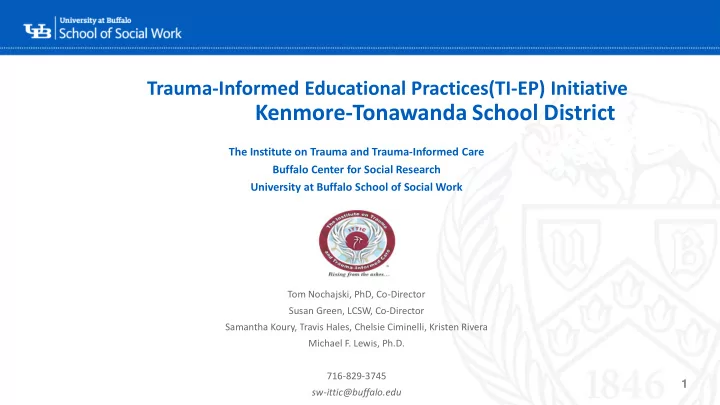

Trauma-Informed Educational Practices(TI-EP) Initiative Kenmore-Tonawanda School District The Institute on Trauma and Trauma-Informed Care Buffalo Center for Social Research University at Buffalo School of Social Work ‘- Tom Nochajski, PhD, Co-Director Susan Green, LCSW, Co-Director Samantha Koury, Travis Hales, Chelsie Ciminelli, Kristen Rivera Michael F. Lewis, Ph.D. 716-829-3745 1 sw-ittic@buffalo.edu
Ken-Ton TI-EP Initiative: 3-Year Project • Evaluation (baseline, midpoint & post) • Training, consultation & coaching for teachers, staff and ‘- community across the School District • Administrative/leadership coaching • Development of an internal “TI-EP Champion Team” 2
Those amongst us Real story…. ‘- 3
Family member of war veteran Medical trauma Being shot at… Domestic Violence Body image issues PTSD of family member Financial struggles 13+ moves across the world Substance use (personal) Bullying Stabbing Physical/Sexual abuse Physical deformity Self harm ‘- Emotional abuse Police brutality Substance using parents Death in the family Survivors guilt Complex trauma Neglect Divorce Gang violence (7 friends lost) Incarcerated parents Homelessness Family dysfunction Observing traumatized family members struggle Having gun put to my head Raid – witnessing arrest of family member Child welfare system 4
‘- 5
Three Levels of Trauma Practice Trauma-Informed – universal precaution; 5 guiding values/principles ‘- Trauma Sensitive – screening/assessing; preventing re-traumatization Trauma Specific – evidence-based, trauma treatment interventions 6
Trauma-Informed Evaluation • ITTIC’s research team will continuously assess your organization’s climate and procedures for alignment with TIC ‘- • The assessment will: o Identify strengths in the organization o Provide work-unit specific data o Monitor progress over time 7
Trauma-Informed Evaluation Instruments • The TIC Climate (34 Items – assesses perception of KENTON climate concerning the five dimensions of TIC – • Safety, • Trustworthiness, ‘- • Choice, • Collaboration and • Empowerment. • Since prior work with varying types of agencies has suggested that High scores on these scales are related to increased compassion satisfaction and increased organizational commitment, as well as decreases in burnout and secondary traumatic stress, in tracking across time we can see how staff are influenced by the training. 8
Trauma-Informed Evaluation Instruments • The TIC Procedures Assessment (Shortened for Kenton – 48 items) covers the following areas: • Support for staff development – training; • Staff development – supervision, support and self-care; • Privacy and Confidentiality; • Open and Respectful Communication; ‘- • Consistency and Predictability; • Delivering Services around Trauma; • Involvement of students and Families in planning process; • Policy Creation; • Review of Policies; • As with the Climate Measure – tracking across time will allow us to assess how the behaviors may have shifted as a function of the training. 9
Trauma-Informed Evaluation Instruments • Organizational Readiness to change – 12 Items covers the following: • Acceptability of Intervention • Intervention Appropriateness ‘- • Feasibility of Intervention • This will provide us with whether specific schools are more or less ready for this type of intervention – can lead to discussion of ordering how we implement – potentially looking to allay fears and provide information concerning the content and impact on the individual. 10
Evaluation Procedures The intention of ITTIC is to do the surveys at the beginning, • midpoint (Year two) and end point (end of Year 3). Staff, Students, and Parents will be receiving surveys • ‘- We will track changes across time in the three measures to see if • training has influenced perceptions of the school system. We will also assess the performance indicators that the Tower • Foundation may request. 11
Tower Foundation Performance Indicators QUALITY INDICATORS QUANTITY INDICATORS % of parents/teachers/staff # of disciplinary referrals /administrators/students demonstrating trauma awareness # of staff trained (by area) % of staff trained (by area) ‘- # of trainings % of parents/teachers/staff # of trauma champion/mentor team meetings /administrators reporting satisfaction with training # of trauma education presentations at PTA meetings % of parents/teachers/staff /administrators reporting that they are likely to use what # of parents attending trauma education presentations at PTA they’ve learned from trainings/presentations meetings % of parents showing awareness of trauma-informed # of focus groups conducted regarding trauma awareness practices in schools # of students responding to trauma survey 12
Tower Foundation Performance Indicators Is anybody Better off #/% of disciplinary referrals resolved in a trauma-sensitive manner ‘- #/% of teacher-student interactions reflecting trauma-sensitivity #/% of absentee days (total counts, not individualized) #/% of students succeeding academically 13
Our Research • The five values of TIC are strongly correlated and share an underlying dimension • Intervention in any one five values will have an effect on the others ‘- Trauma- Informed Care Empowerment Safety Trust Collaboration Choice 14
Outcome Studies • Implementing TIC has been associated with: • Improvements in staff satisfaction • Reductions in unplanned discharges ‘- • The five values of TIC have been: • Positively associated with organizational commitment and compassion satisfaction , and • Negatively associated with burnout and secondary traumatic stress 15
Correlations Table 1. Selected Correlations of TIC Constructs and Outcome Variables (N=197). Secondary Compassion Organizational Variable Burnout Traumatic Stress Satisfaction Commitment Safety -.433** -.365** .472** .540** ‘- Trust -.409** -.260** .378** .593** Choice -.382** -.208** .466** .624** Collaboration -.360** -.221** .348** .623** Empowerment -.399** -.287** .455** .658** Note . ** p < .01. 16
Trust/ Trust/ Safety/Collaboration/ collaboration Choice Passion for Respect for Excellence all ‘- Trust/ Integrity/ Trauma-Informed Educational Empathy Teamwork Practices In Action… Collaboration/ Trust/Safety Empowerment 17
Recommend
More recommend